State the underlying principle of a transformer. How is the large scale transmission of electric energy over long distances done with the use of transformers ?
A transformer is based on the principle of mutual induction. When an alternating current is passed in the primary coil, magnetic flux in the primary coil and, consequently, in the secondary coil changes. As a result, an induced voltage is set up in the secondary coil also, whose magnitude depends on relative number of turns in primary and secondary coils. Large scale transmission of electric energy over long distances for a.c. power is done at highest possible voltage so that line current is less and consequently power loss during transmission is least possible. It is achieved by use of step up transformers at the generating station. At the consumer station, using step down transformers, the power is again supplied to homes and establishments at comparatively low voltages.
Topper's Solved these Questions
- ALTERNATING CURRENT BOOK - U-LIKE SERIESCHAPTER - ALTERNATING CURRENT EXERCISE - LONG ANSWER QUESTIONS -I
26 Videos
- ALTERNATING CURRENT BOOK - U-LIKE SERIESCHAPTER - ALTERNATING CURRENT EXERCISE - LONG ANSWER QUESTIONS -II
12 Videos
- ALTERNATING CURRENT BOOK - U-LIKE SERIESCHAPTER - ALTERNATING CURRENT EXERCISE - VERY SHORT ANSWER QUESTIONS
28 Videos
- ATOMSBOOK - U-LIKE SERIESCHAPTER - ATOMSEXERCISE - SELF ASSESSMENT TEST (SECTION C)
2 Videos
Similar Questions
State the underlying principle of transformer. How is the large scale transmission of electric energy over long distances done with the use of transformers?
View SolutionCase study :
Read the following paragraph and answers the questions :

The large-scale transmission and distribution of electrical energy over long distances is done with the use of transformers. The voltage output of the generator is stepped-up. It is then transmitted over long distances to an area sub-station near the consumers. There the voltage is stepped down. It is further stepped down at distributing sub-stations and utility poles before a power supply of 240 V reaches our homes.
We need to step-up the voltage for power transmission, so that
View Solution
Knowledge Check
The underlying principle of transformer is
AresonanceBmutual inductionCself inductionDnone of the above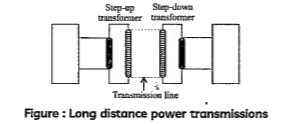
Figure : Long distance power transmissions The large-scale transmission and distribution of electrical energy over long distances is done with the use of transformers. The voltage output of the generator is stepped-up. It is then transmitted over long distances to an area sub station near the consumers. There the voltage is stepped down. It is further stepped down at distributing sub-stations and utility poles before a power supply of 240 V reaches our homes.
We need to step-up the voltage for power. transmission, so that:AThe currentis reduced and consequently, the I2R loss is cut downBThe voltage is increased, the power losses are also increasedCThe power is increased before transmission is doneDThe voltage is decreased so V2R losses.are reduced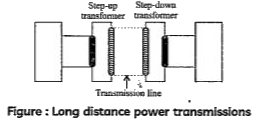
Figure : Long distance power transmissions The large-scale transmission and distribution of electrical energy over long distances is done with the use of transformers. The voltage output of the generator is stepped-up. It is then transmitted over long distances to an area sub station near the consumers. There the voltage is stepped down. It is further stepped down at distributing sub-stations and utility poles before a power supply of 240 V reaches our homes.
If the secondary coil has a greater number of turns than the primary,AThe voltage is stepped-up (Vs>Vp) and arrangement is called a step-up transformerBthe voltage is stepped-down (Vs<Vp) and arrangement is called a step down transformerCthe voltage is stepped-down (Is>Ip) and arrangement is called a step down transformerDthe voltage is stepped-down (Is<Ip) and arrangement is called a step down transformer
Case study :
Read the following paragraph and answers the questions :
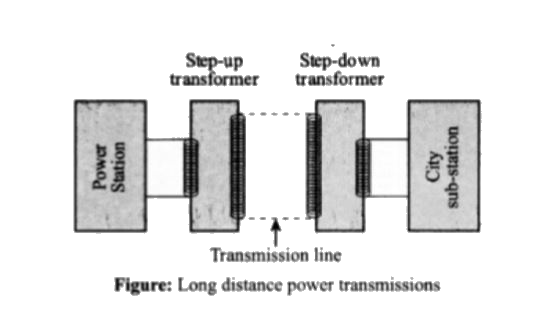
The large-scale transmission and distribution of electrical energy over long distances is done with the use of transformers. The voltage output of the generator is stepped-up. It is then transmitted over long distances to an area sub-station near the consumers. There the voltage is stepped down. It is further stepped down at distributing sub-stations and utility poles before a power supply of 240 V reaches our homes.
If the secondary coil has a greater number of turns than the primary,
View SolutionCase study :
Read the following paragraph and answers the questions :
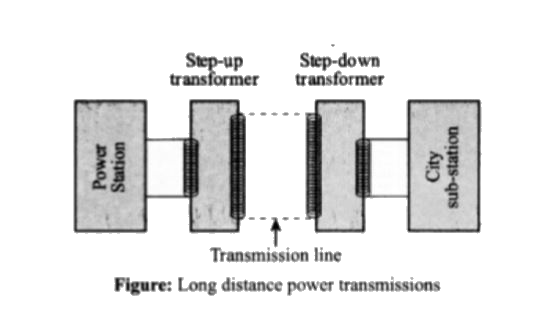
The large-scale transmission and distribution of electrical energy over long distances is done with the use of transformers. The voltage output of the generator is stepped-up. It is then transmitted over long distances to an area sub-station near the consumers. There the voltage is stepped down. It is further stepped down at distributing sub-stations and utility poles before a power supply of 240 V reaches our homes.
Which of the following statement is true?
View SolutionCase study :
Read the following paragraph and answers the questions :
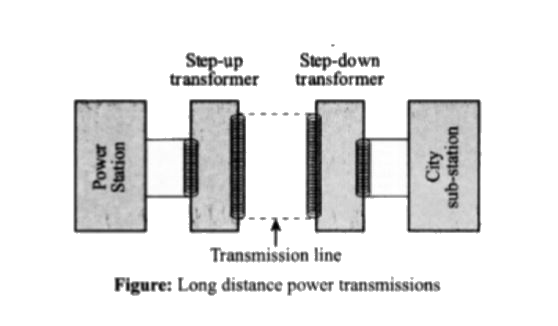
The large-scale transmission and distribution of electrical energy over long distances is done with the use of transformers. The voltage output of the generator is stepped-up. It is then transmitted over long distances to an area sub-station near the consumers. There the voltage is stepped down. It is further stepped down at distributing sub-stations and utility poles before a power supply of 240 V reaches our homes.
A power transmission line feeds input power at 2300 V to a step down transformer with its primary windings having 4000 turns. The number of turns in the secondary in order to get output power at 230 V are
View Solution
Figure : Long distance power transmissions The large-scale transmission and distribution of electrical energy over long distances is done with the use of transformers. The voltage output of the generator is stepped-up. It is then transmitted over long distances to an area sub station near the consumers. There the voltage is stepped down. It is further stepped down at distributing sub-stations and utility poles before a power supply of 240 V reaches our homes.
Which of the following statement is true?
View Solution
Figure : Long distance power transmissions The large-scale transmission and distribution of electrical energy over long distances is done with the use of transformers. The voltage output of the generator is stepped-up. It is then transmitted over long distances to an area sub station near the consumers. There the voltage is stepped down. It is further stepped down at distributing sub-stations and utility poles before a power supply of 240 V reaches our homes.
A power transmission line feeds input power. at 2300 V to a step down transformer with its primary windings having 4000 turns. The number of turns in the secondary in order to get output power at 230 V are :
View Solution
